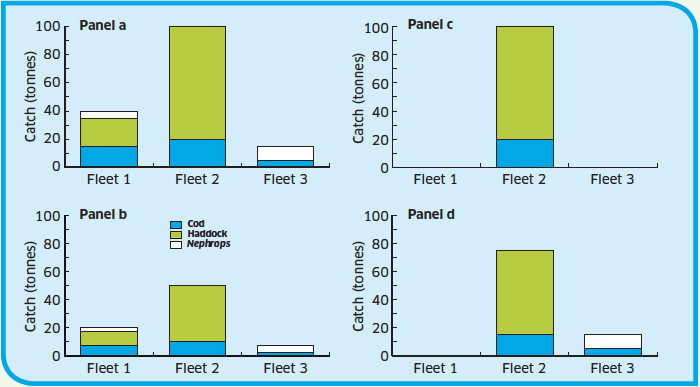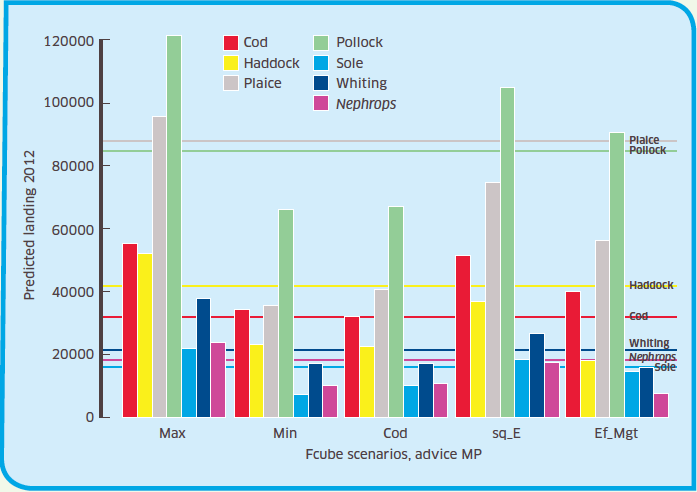Revised editon: Fish and Shellfish Stocks: 2014 Edition
Information on the state of fish and shellfish stocks of commercial importance to the Scottish fleet, inclduing Total Allowable Catches (TACs) for each stock.
Mixed Species Fishery Advice
Introduction
The International Council for the Exploration of the Sea ( ICES) has traditionally given fishery management advice on an individual stock basis. For each assessed stock, catch options corresponding to the formal ICES advice are provided for the following year and form the basis of the Total Allowable Catch ( TAC) for that stock. The TAC is the total landing allowed to be taken from that stock by all fleets. For demersal fisheries in particular this approach is deficient since it disregards the fact that mixtures of roundfish, flatfish and shellfish are often caught simultaneously within a single fishery. Moreover, fish stocks are targeted by different fleets, each catching different mixes of species. Ignoring the mixed-species aspect of fisheries can mean, for example, that the quota for one species may become exhausted, but due to the continued quota availability for other species, vessels continue to fish and inevitably catch the species whose quota is exhausted. The required constraints on fishing mortality for vulnerable species are not always therefore operative. Alternatively, early closure of a fishery because one species needs protection could result in the loss of fishing opportunities on other stocks.
Approaches investigated
Both ICES and the European Commission are investigating ways to advise on and manage mixed-species fisheries. One option is that advice is provided on a fleet or fishery basis. This requires evaluation of fisheries in a multi-fleet framework. Management under such a framework requires judgements from fishery managers on the relative species importance, since broadly equivalent outcomes for one species may be reached in a number of ways with very different restrictions on other species. A simple example of management options for three fleets catching three species (cod, haddock and Nephrops) is illustrated below. Panel 'a' shows the historic catch composition. Fleet one catches a mixture of all three species, fleet two catches cod and haddock, and fleet three cod and Nephrops. Now imagine that catches of haddock and Nephrops can be maintained but there is a need to protect cod and reduce catches of it by 50%. Panel 'b' shows the effect on the catches of all three species of reducing cod catches evenly across all fleets. Panel 'c' shows the option where priority is also given to maintaining haddock catches, and results in closing down fleets one and three. Panel 'd' shows the outcome of prioritising cod, then Nephrops and finally haddock. This distributes the permissible cod catches firstly to the catch associated with Nephrops in fleet three and then to a significant but lesser extent to the catch associated with haddock in fleet two. Thus managers have complex decisions to take, but the mixed fisheries approach can help to maximise fishing opportunities.

Current practice and future possibilities
The European Commission's Scientific, Technical and Economic Committee for Fisheries ( STECF) made initial attempts at mixed fisheries forecasts using the MTAC approach (after Mixed- species TAC), from 2004. Attempts to use MTAC in an advisory context led to the identification of a number of limitations with the approach and, as a result, ICES established a series of workshops between 2006 and 2009 to establish a simpler model in line with the availability and accessibility of data. Together with two EU- funded research projects this established the Fcube model (after Fleet and Fishery Forecast). Fcube was run within a mixed fisheries advice working group for the first time in 2010 and to date its application has been restricted to demersal fisheries and stocks within the North Sea, Skagerrak and Eastern Channel.
Two basic concepts of primary importance to Fcube are the Fleet (or Fleet segment), and the Métier defined as:
- A Fleet segment is a group of vessels with the same length class and predominant fishing gear during the year. Vessels may have different fishing activities during the reference period, but might be classified in only one Fleet segment.
- A Métier is a group of fishing operations targeting a similar (assemblage of) species, using similar gear, during the same period of the year and/or within the same area and which are characterized by a similar exploitation pattern.
The exploitation pattern of each species is the distribution of fishing mortality over the different ages of that species.
The species considered as part of the demersal mixed fisheries of the North Sea are cod, haddock, whiting, saithe, plaice, sole and Nephrops norvegicus. By 2011 all of these were subject to multi-annual management plans, apart from Nephrops. These plans all consist of harvest rules evaluated and adopted on a stock-by-stock basis, and derive the annual TACs depending on the biomass of the stock relative to biomass reference points and a target fishing mortality. The harvest rules also impose constraints on the annual percentage change in TAC. The basis of the Fcube model is to estimate the potential future levels of effort by fleet corresponding to the fishing opportunities based on:
- The results of the single species advice and management plans.
- The fleet's effort distribution across metiers.
- The catchability of each species by each métier.
- An assumption regarding the behaviour of each fleet in the forecast year.
Examples of assumptions of fishers' behaviour are the 'max' scenario: where a fleet continues fishing until all quotas are exhausted, the effort management scenario: where fleets are assumed to use the same effort as in the most recent year except those using gear subject to reduced effort ceilings under EU legislation or the 'cod' scenario: where fleets are assumed to stop fishing once their quota of cod is exhausted.
To date, no single assumption on fishers' behaviour (or even a single set of fleet specific assumptions varying across fleets) has been adopted and therefore no mixed fisheries advice as such has been produced. Instead several forecasts are made, each according to a scenario where the same assumption about fleet behaviour is made for all fleets. The resulting overall catches by species are presented to fisheries managers as a set of potential outcomes given all else remains as before.
These potential outcomes can be presented in the figure below. The horizontal lines represent the TACs from the single species advice. Columns representing the potential 'landings' of each stock considered are grouped together by scenario. A column finishing under its associated horizontal line represents underutilised quota for that species. A column finishing above its associated horizontal line represents landings over and above the proposed TAC. In the latter case, if the scenario was to hold true and the TAC remained unchanged, then the excess 'landings' would become discards or potentially unreported landings. The figure only shows the result of projecting the landings component of the fleets' catches. If one or more fleets already discard a proportion of the catch an amount representing discards would have to be added to the columns.

This form of mixed fisheries forecasting is in its infancy. The projection of status quo catchabilities is a weakness of the current approach and the scenarios considered by ICES so far are simple and uniform across fleets. Fishermen have demonstrated the ability to reduce by-catch through season, area or gear modifications, or changes in their short term fishing patterns. There is a danger that the allocation of fishing opportunities based on past catch compositions will lock fisheries into their historical pattern, providing no incentive to reduce by-catch. More complex models of behaviour could potentially be 'plugged in' to the mixed fisheries short term projections but modelling adaptive changes in fishing behaviour is still in development. Another limitation is the availability of data. Any data to be used in a mixed fisheries context ( e.g. running costs by fleet, so that the cost of utilising different quotas can be considered) have to be available across all fleets and/or stocks. For 2012, the mixed fisheries working group will move to May and its results will be available alongside the single species advice from ICES. Mixed fisheries advice should still only be seen as being in its early stages and it is not ecosystem management. Even so it can be seen as a means to bridge the gap between 'traditional' fisheries management and the development of an ecosystem approach to marine management.
Contact
There is a problem
Thanks for your feedback